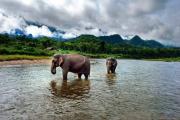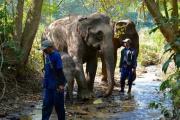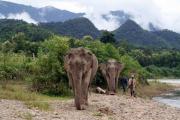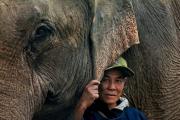How modern elephant tourism might – or should – look
By JJ Rose
BACK IN 2008, my wife, four-year-old daughter and I signed up for an elephant riding experience near Luang Prabang in Laos.
We met our living transports in a seedy mahout jungle camp, and fed them some bananas before saddling up and heading off for a mildly adventurous trek through forests, over the hills and, most memorably, through a knee-deep (for the elephants) creek. Being animal lovers, we enjoyed spending time with these regal and gentle giants.
We’d told ourselves that the sharp hook the mahouts occasionally dug into the elephant’s skull as we rode was ‘barely felt’ by the lumbering pachyderm beneath us. The elephants looked a little thin, but we convinced ourselves that it was just because of the season, or that they were exercised a lot and were really fit.
What we didn’t think of then was that those elephants were probably very unhappy, very hungry, and very abused.
Visiting the Mandalao elephant camp
Ten years later, I’m back in Luang Prabang and thinking about elephants again. But I’m more educated this time, and it appears I’m not the only one.
There used to be signs along Sisavangvong Road — Luang Prabang’s main tourist strip — inviting visitors to ride elephants; now many were touting ‘no ride’ policies and sustainable experiences.
As Asian animal-based tourism — hanging out with anything from orangutans to tigers, from petting zoos to elephant rides — grows in economic terms, animal welfare and conservation impacts appear to have taken the back seat. Many of those who pay for various animal experiences throughout the region would identity themselves as animal lovers, but most are horribly uneducated about the consequences of this burgeoning form of ‘experiential’ travel.
About an hour’s drive from Luang Prabang, through tumbling jungle and thatch hut villages, along red mud roads in the teeming rain, is the Mandalao elephant camp. One of the many operators touting for custom along Luang Prabang’s main street, Mandalao was recommended to me by more than one animal rights NGO (non-government organisation) in the field.
Mandalao looks after eight adult elephants and one juvenile at its property just outside the Ban Xieng Lom village. Their pachyderm charges consume most of their food roaming freely in the wild and their diets are supplemented (about one-third of the total daily intake) by a variety of local produce ‘treats’ like pineapples and banana trees.
Restrictive chains are banned during the day, but the elephants are apparently sometimes chained at night for health or welfare reasons.
We arrange ourselves gingerly into motorised river rafts and cross the seething, brown river to get to the elephant feeding area. The animals come here by free choice, and aren’t rounded up for voyeuristic tourists.
Unlucky visitors might not see any elephants at all, but they do generally show up to enjoy the juicy banana leaves and other delights on offer. Or, perhaps, they themselves want a chance to eye some two-legged visitors with their piercing, omniscient elephant gaze.
Despite the heavy rain, two faithful grey beasts turn up to check us out and have a feed. There aren’t any chains in sight, and no restraint on the animals’ movement, other than the gentle nudgings and grunts of their mahouts.
We are warned about elephant etiquette and behaviour, such as never approaching an elephant from the rear, or recognising gently flapping ears as a sign of them being happy and relaxed, while ears out and still is quite the opposite. We are allowed to mingle as they munch through what look like whole banana trees, as thick as fence posts. The elephants stomp on the trees, twist them with their trunks and crunch on them.
The lucrative ‘elephantourism’ industry
‘Elephantourism’ is arguably the leading sector in Asia’s huge animal-based tourist industry. Despite this — or perhaps because of it — little data has been generated in relation to animal welfare and the impacts of using animals as tourist attractions, often in captivity.
There are an estimated 25,000 Asian elephants in captivity, roughly half the entire population of this endangered species (Asian elephants are actually three subspecies, found in Sri Lanka, Sumatra and the Asian mainland).
Tourism therefore impacts crucially, not only the quality of life of individual elephants, but on the species as a whole.
A 2017 report by UK-based World Animal Protection (WAP) suggests the industry has been addressing such concerns poorly, if at all.
The organisation studied the living conditions of almost 3,000 individual elephants at 220 tourism operations across Asia between 2014 and 2016. They found that 77 percent, or 2,242 animals, were “kept in severely inadequate conditions”. Only 194 of the animals were kept in what the authors considered “best possible under captive conditions”.
Asian elephants can grow up to 6m in length, and weigh up to 5,000kg. In the wild, they live up to 70 years. They are highly evolved social animals and often live in herds of between 20 and 100 females and children; males tend to live alone or in loose male groups when mature. A mature elephant will walk up to 10km every day foraging for the 150–300kg of food it eats daily. Elephants are on the move as much as 18 hours a day and generally only need to sleep a few hours each day.
Such needs are difficult for many tourism operators to meet. Instead, elephants are kept in small pens, denied proper social interaction, fed poor and inadequate amounts of food, or are deprived of exercise.
The process of ‘breaking in’ an elephant captured from the wild — as most still are — can also be particularly vicious.
While in Luang Prabang, I watched a 1927 docudrama called Chang. In the movie, a baby elephant is caught and used as bait to attract its mother. Mother and child are then bound tightly by bamboo poles and ropes for days, left unfed and unwatered.
Given the age of the film, I’d assumed that this draconian approach was an anachronism. But when I asked people working in the elephantourism industry about it, I was told — without anyone wanting to go on the record — that not a lot has changed.
This cruelty has long-term effects; researchers have recorded elephants experiencing emotions we would know as grief and post-traumatic stress disorder.
Given the trauma of their capture, can elephantourism really be sustainable? Should they be in captivity at all?
Mandalao, for one, is seeking to reverse the captivity trend by working with government authorities to release elephants into the adjacent Nam Phouy National Park.
But Associate Professor in Veterinary Medicine and Director of Elephant and Wildlife Research at Thailand’s Chiang Mai University, Chatchote Thitaram says that it isn’t the captivity that’s the issue.
“Elephants have been captured and used in captivity for 4,000 years,” he tells New Naratif. “Elephants in tourism is a sustainable way for captive elephants. However, [the] training should be adjusted, in both positive and negative ways to let elephants understand their roles to live in harmony with humans.”
But other experts, such as the WAP, say that less violent and more cooperative training regimes can prove dangerous. Its 2017 report argues that “relying on an elephant’s cooperative will to ensure the safety of handlers and visitors during stressful, demanding situations, such as rides and shows, or any other situation leaving people unprotected, is a serious risk to human safety.”
Boycott or reform?
With the jury still out on whether elephantourism should even exist as an industry, animal-loving tourists are presented with a dilemma: either boycott the industry, or patronise tourism operators while hoping that the elephants are well looked after.
“A true elephant-friendly venue would be purely observational for visitors, where the safety of visitors and wellbeing of elephants is not affected by the need to constantly control the animals,” says the WAP.
As we walked alongside our new elephant friends through the jungle, getting very wet and muddy, it struck me that discomfort is perhaps a condition for a wildlife experience.
Spending time in their environment, on their terms, even a mild risk, would seem to be the appropriate conditions for a wild animal experience.
On this tour, we waited while the animals foraged or socialised. We walked with them through their habitat. We lined up for pats and selfies, but only when they had stopped. We asked nothing of them, other than to spend some time with them. They seemed to enjoy the connection too and engaged with us with their mobile trunks and ever-active eyes.
I wonder if there was some mutual respect that grows from such an interaction, which not only deepens the experience, but perhaps goes some way to ensuring the welfare of visitors – along with the elephants – is maintained.
Perhaps the way forward is, on the surface, quite simple. It’s about us making an effort and being prepared to suffer the randomness and discomforts of nature.
We need to accept that a true natural experience is neither predictable nor designed just for us. Accepting those points as tourists, and expecting tourism operators to respect that, may be the future of sustainable elephantourism.
JJ Rose was a guest of Mandalao Tours.
#ends
LOCATION: LUANGPRABANG, LAOS
- Hits: 1485









